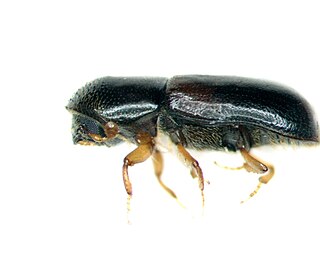Gnathotrichus pilosus is a species of ambrosia beetle in the family Curculionidae. It is found in North America.
Gnathotrichus retusus, the western pinewood stainer, is a species of ambrosia beetle in the family Curculionidae. It is found in North America.

Trypodendron lineatum, known generally as striped ambrosia beetle, is a species of typical bark beetle in the family Curculionidae. Other common names include the two-striped timber beetle, conifer ambrosia beetle, and spruce timber beetle. It is found in Europe and North America.
Trypodendron betulae, the birch ambrosia beetle, is a species of typical bark beetle in the family Curculionidae. It is found in North America.

Scolytus mali, known generally as larger shothole borer, is a species of typical bark beetle in the family Curculionidae. Other common names include the apple bark beetle and large fruit bark beetle. It is found in North America.
Dendroctonus jeffreyi, known generally as the Jeffrey pine beetle or mountain pine beetle, is a species of crenulate bark beetle in the family Curculionidae. It is found in North America. The Jeffrey pine beetle is monophagous on the Jeffrey pine tree, a dominant yellow pine and most concentrated in areas ranging from Southwestern Oregon to Baja California to western Nevada. In its native range, it causes a significant amount of damage as large numbers of tree mortality have been documented. It is known to cause significant changes to the composition and structure of the Jeffrey pine tree.

Phloeosinus cupressi, the cypress bark beetle, is a species of crenulate bark beetle in the family Curculionidae. It is found in North America.
Corthylus punctatissimus, the pitted ambrosia beetle, is a species of typical bark beetle in the family Curculionidae. It is found in North America.
Cryphalus ruficollis is a species of bark beetle in the family Curculionidae that lives in North America.

Gnathotrichus materiarius, the American utilizable wood bark beetle, is an ambrosia beetle in the family Curculionidae. It is native to North America, but has been introduced to several European countries. It lives in symbiosis with the fungus Endomycopsis fasciculata, which adult beetles inoculate into the wood of host trees - the fungus then acts as the primary food source of the larvae and adults.
Hypocryphalus mangiferae, known generally as the mango bark beetle or shoot gun perforator, is a species of typical bark beetle in the family Curculionidae.

Xylosandrus germanus, known generally as the alnus ambrosia beetle or black stem borer, is a species of ambrosia beetle in the family Curculionidae. The black stem borer is native to eastern Asia, but is an invasive species in Europe and North America. It carries an associated ambrosia fungus, Ambrosiella grosmanniae.

Xyleborinus saxeseni, known generally as the fruit-tree pinhole borer or keyhole ambrosia beetle, is a species of typical bark beetle in the family Curculionidae. Other common names are common Eurasian Ambrosia Beetle, Asian Ambrosia Beetle; Lesser Shot Hole Borer. It is found in North America. X. Saxeseni is primarily a temperature zone species, although it does appears in some areas in more tropical climates. Length is about 2–2.4 mm (0.079–0.094 in), 2.6-3.0 times longer than wide.
Pandeleteius buchanani is a species of broad-nosed weevil in the beetle family Curculionidae. It is found in North America.
Huaca guayra is a species of true weevil in the beetle family Curculionidae. It is found in North America.
Coccotrypes distinctus is a species of typical bark beetle in the family Curculionidae. It is known from Sri Lanka, Pacific Islands from New Guinea to Hawaii, southern USA, Honduras, Puerto Rico and Jamaica to Suriname and Guiana.
Epicaerus benjamini is a species of broad-nosed weevil in the beetle family Curculionidae. It is found in North America.
Anthonomus tectus is a species of true weevil in the beetle family Curculionidae. It is found in North America.
Anthonomus elongatus is a species of true weevil in the beetle family Curculionidae. It is found in North America.
Gnathotrichus sulcatus, the western hemlock wood stainer, is a species of ambrosia beetle in the family Curculionidae. It is found in North America.





